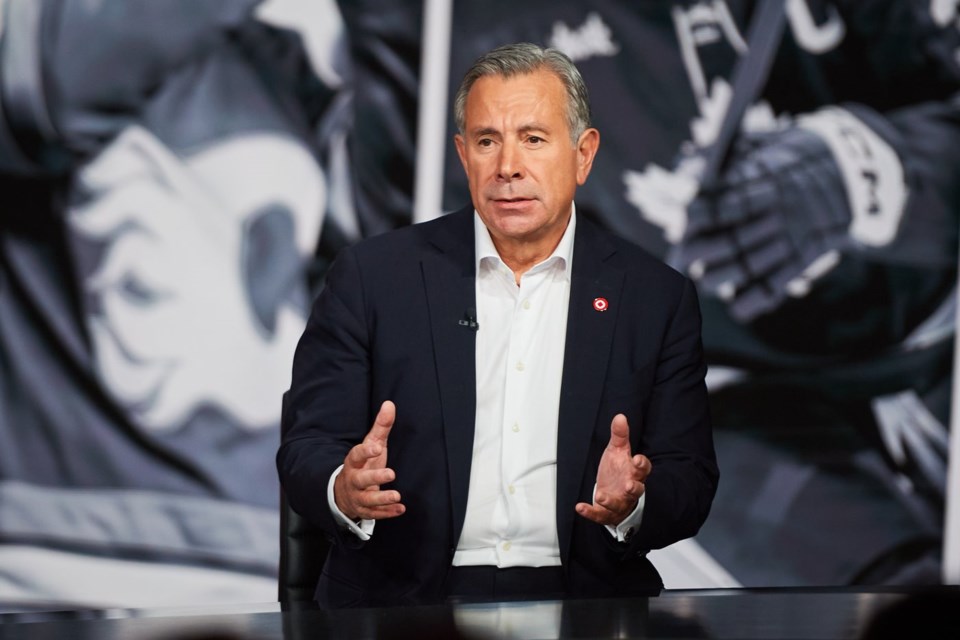TORONTO — Rogers Communications Inc. hopes to find "revenue and cost synergies" in its expanded portfolio of sports assets after becoming the majority owner of Maple Leaf Sports & Entertainment.
The Toronto-based telecom company believes its stock price undervalues its media and sports holdings and says it is "pursuing all options ... to monetize and surface the very substantial unrecognized market value" of those assets.
Earlier this month, Rogers completed its $4.7-billion deal with rival BCE Inc. to buy its 37.5 per cent stake in MLSE. The acquisition, which closed July 1 after receiving the necessary regulatory and league approvals, made Rogers the majority owner of the sports conglomerate that owns the NHL's Maple Leafs, NBA's Raptors, CFL’s Argonauts, MLS’ Toronto FC and AHL’s Marlies.
Rogers also owns MLB's Toronto Blue Jays.
"On sports and media, it's clear that there is significant underlying value and we are squarely focused as we put the assets together ... to continue to strengthen our balance sheet," said Rogers president and CEO Tony Staffieri on a conference call Wednesday, as the company reported its latest earnings.
"The second part of our task is to surface the value for shareholders. We continue to work through the various options and the good news is we have very good options in front of us."
Staffieri said it was premature to provide further insight about possible "synergies" within MLSE, but that Rogers would likely share details of its plans before the end of 2026.
He said Rogers has "a very good track record" in finding ways to operate more efficiently, pointing to its 2023 merger with Shaw Communications Inc.
"We went into this transaction with a view that we could execute on very strong synergies across our sports and media properties and certain things that need to happen before we can execute on those," he said.
"But the thinking, the planning is underway and at the right time ... we can be more specific."
Some industry watchers have speculated about the potential for Rogers to eventually fold the Blue Jays and related stadium assets into MLSE — an option floated by one analyst on the conference call who questioned if that's where Rogers might stand to eliminate "redundant costs" within its sports portfolio.
"I expect that as we roll in the Toronto Blue Jays' Rogers Centre with Scotiabank Arena and the other venues within MLSE and the sports teams within MLSE, we will find revenue and cost synergies," chief financial officer Glenn Brandt replied.
Meanwhile, the company updated its financial guidance on Wednesday to reflect the MLSE deal. Rogers now expects service revenue to increase three to five per cent year-over-year in 2025, up from its previous forecast of zero to three per cent growth, as a result of the anticipated contribution from MLSE.
Rogers reported its second-quarter profit declined compared with a year ago as a result of higher restructuring, acquisition and other costs. The company said it earned $148 million or 29 cents per diluted share attributable to shareholders for the quarter ended June 30.
The result was down from a profit of $394 million or 73 cents per share in the same quarter last year.
Restructuring, acquisition and other costs totalled $238 million in the quarter, up from $90 million a year ago.
Revenue for the three-month period totalled $5.22 billion, up from $5.09 billion a year earlier. Wireless service revenue was up one per cent from a year ago as its subscriber base grew, while wireless equipment revenue increased 13 per cent, primarily as a result of higher device sales to existing customers.
Media revenue rose 10 per cent, boosted by strong NHL playoff audiences on Sportsnet and the launch of the Warner Bros. Discovery suite of television channels. Cable revenue was up one per cent.
On an adjusted basis, Rogers earned $1.14 per diluted share, down from $1.16 per diluted share in the second quarter of 2024.
The results came as the company reported 61,000 total mobile phone net subscriber additions, including 35,000 postpaid — down from 112,000 postpaid additions in the same quarter last year.
Rogers' monthly churn for net postpaid mobile subscribers — a measure of those who cancelled their service — was 1.00 per cent, down from 1.07 per cent during its previous second quarter.
Scotiabank analyst Maher Yaghi said the results were "broadly in line with expectations."
"Wireless subscriber loading was relatively healthy given continued Canadian market normalization as a result of lower population growth," he said in a note.
"While financial results do clearly show the impact from significant pricing pressures, we believe recent price ups which we saw since early June provide a more positive backdrop for the industry."
The company recorded 26,000 prepaid net additions in the quarter, compared with 50,000 prepaid subscriber additions in the second quarter of 2024.
Meanwhile, Rogers' mobile phone average monthly revenue per user was $55.45, down from $57.24 in the second quarter of the prior year.
Retail internet net additions totalled 26,000.
This report by The Canadian Press was first published July 23, 2025.
Companies in this story: (TSX: RCI. B)
Sammy Hudes, The Canadian Press




